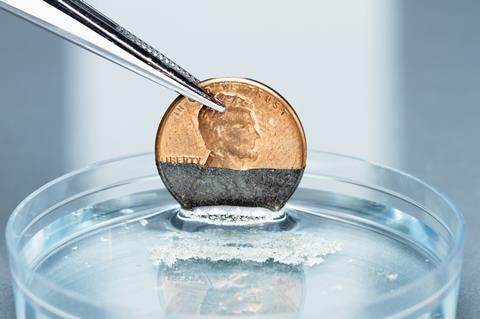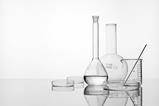Ensure students don’t feel out of place as they learn about reactive metals
How do railway engineers join together 50-metre-long rail tracks so that they can stand up to trains rolling past at over 100 mph? Hand welding would be time consuming and assessing the quality of these deep welds would also be tricky out on the track. Instead, engineers turn to some of chemistry’s most spectacular reactions for the solution – metal displacement reactions. A mixture of aluminium and iron oxide is ignited, and liquid iron flows into the joint.

What students need to know
- Metals can be placed in order of reactivity in the ‘reactivity series’.
- A more reactive metal will displace a less reactive metal from its compound.
- Carbon and hydrogen are included in the reactivity series.
- The reactivity series can be used to make predictions about possible reactions.
Ideas for the classroom
Your students will probably have come across the idea of metals being displaced from compounds, such as in the context of extracting metals from their ores. From these reactions, we can start to construct a reactivity series. Any metal that can be extracted from the metal oxide by reaction with carbon must be less reactive than carbon.
Download this
- Reactivity series strips as MS Word or pdf, and a Displacement reaction grid for formative assessment as MS Powerpoint or pdf.
- Integrated instructions as MS Word or pdf for a microscale practical investigating the reaction of metals with metal compound solutions.
- Displacement reaction snap as MS Word or pdf.
Reactivity series strips, and a Displacement reaction grid for formative assessment; integrated instructions for a microscale practical investigating the reaction of metals with metal compound solutions; and Displacement reaction snap from the Education in Chemistry website: rsc.li/2OfpmtQ
As previous generations of chemists discovered, many metals cannot be extracted with carbon. The discovery and use of electricity was required to extract these reactive metals (group 1, group 2, aluminium). These are placed above carbon in the reactivity series. The tales of Humphry Davy’s experiments at the Royal Institution provide fascinating insights into the development of scientific knowledge.
Provide students with a copy of the reactivity series, which they can refer to over time. Some students will want to learn the series – developing mnemonics for this can be helpful. However, this isn’t necessary, and could be just as off-putting as learning the periodic table may be. Having an idea of where groups of metals are on the series could be helpful, for example being aware that the more reactive groups are at the top and jewellery metals are at the bottom. Knowing how to use the series would also be helpful.
Practical chemistry

A quick way for students to confirm the validity of the reactivity series is by using basic electrochemistry. You could adapt the Electricity from chemicals practical, by setting up different cells around the laboratory for the students to collect data. This will also give them a preview of the link between metal reactivity and electricity, useful when discussing extraction by electrolysis.
The key practical to carry out here is investigating the reaction of metals with metal compound solutions. This is best carried out as a microscale reaction, using only a few drops of the solutions and small pieces of the metal. This will limit the volumes of solutions required, and simplify the clearing-up process. If you can, get the solutions in dropper bottles as this will minimise the risk of cross-contamination. The reactions can be carried out on drop tiles, or on the integrated instruction sheets inside plastic wallets. Provide a couple of sieves over jugs for students to tip their reaction mixtures into at the end of the practical.

It may be worth demonstrating a couple of reactions using a visualiser beforehand, especially those that tend to bubble. This can occur as some of the solutions are slightly acidic and the reactive metals will evolve hydrogen. Students may incorrectly identify this as a displacement reaction. They should be observing the production of new metals – copper forming on more reactive metals tends to be the most obvious observation, along with the change in colour of the solutions. Ask students to write word equations for the reactions they observe, and justify them with reference to the reactivity series.
Students can consolidate their use of the reactivity series with a game of Displacement reaction snap. In pairs, students shuffle the cards and deal out an equal number to each person. Then, at the same time, the two students place their next cards face up. If a reaction occurs, for example if magnesium and copper nitrate are shown, the first student to shout ‘reaction’ wins the cards. Other combinations of cards will require different responses. For example, if two metals are shown, the most reactive metal should be shouted out. Students can have a copy of the reactivity series to refer to.
Linking back to the context of joining railway tracks together brings in the spectacular thermite reaction. The RSC and the CLEAPSS versions are both available – practise these carefully before demonstrating in front of a class, following the detailed risk assessments. You can carry out other spectacular demonstrations such as silver nitrate and magnesium, but these are best carried out by very experienced teachers, or via video demonstration (see Part 9).
Formative assessment
Provide students with plenty of practice to consolidate their understanding of using the reactivity series. One simple way of doing this is to display a grid of metals and compounds on the board, and ask students to write word equations on their mini whiteboards. Provide examples of where reaction doesn’t occur; in these cases they should clearly indicate ‘no reaction’ on their whiteboards. Once they are confident in this, provide them with some contextualised questions so they can try to extract the information. Here is an example task: ‘Scrap metal iron is used to extract copper from a solution of copper sulfate produced by bacteria feeding on low-grade copper ores. Write a word equation for the displacement reaction, and explain why this method works.’
Common misconceptions
The main misconception could stem from our own and students’ inappropriate language use regarding substances and their reactions. This comes from giving chemicals human characteristics – for example, the atom ‘wants’ a full outer shell. It’s tempting to use analogies such as metals being two males competing for the attention of the female oxygen. However, this can cause students to think about substances as having thoughts and emotions. If you do use these analogies, be very clear that they are just that – an aid to understanding a reaction. Without going into great depth, you can indicate that the products are more energetically stable than the reactants, and this drives the reaction. Leave the detailed discussion of energetics to 14–16 chemistry (and entropy to 16–19).
Progression to 14–16
As students progress to 14–16 chemistry, they will learn further details about displacement reactions in terms of electron transfer. Metal displacement reactions are redox equations, with the more reactive metal being oxidised, and the less reactive metal being reduced. The use of reactions of metals to produce electricity will be studied with electrochemical cells. This will make the processes of electrolysis more explicable and help to complete the conceptual circle back to extraction of metals from compounds.
Take-home points
- More reactive metals will displace less reactive metals from their compounds.
- Take care not to imply substances have feelings or preferences – couch your explanations in terms of energetic stability.
- Ensure students have ready access to the reactivity series, and that they refer to it regularly.
- Displacement reactions are a form of redox reaction.














6 readers' comments